The global healthcare system is undergoing a massive shift. Nonetheless, modern mobile healthcare solutions can effectively tackle most traditional and emerging problems within the system.
Industries worldwide are undergoing disruptive changes thanks to the rapid evolution of modern technologies and the pandemic-driven need for better and faster digital solutions. This phenomenon has led to new problems regarding efficiency arising and modern apps providing solutions to those problems. For example, the restaurant industry had to modernize its online delivery systems with faster on-demand food services. The banking industry was upended and pushed into mobility with the proliferation of FinTech apps. And social media had to target communication issues and develop new ways of helping their user communicate online. Healthcare, however, is unique from the rest of the industries mentioned. It has a wide variety of issues that impact it, aside from the pandemic, and tackling them is challenging for stakeholders, especially for healthcare app developers. We are the gatekeepers of the mobile healthcare ecosystem, and as such, it is our responsibility to build the mobile solutions that solve healthcare’s most pressing problems–and quickly. This is where healthcare mobile apps come into play.
The silver lining of the pandemic is that it drove digital healthcare initiatives forward. Henceforth, healthcare app development is at the beginning of its golden age, and the most sustainable and innovative healthcare mobile apps will be the ones that provide solutions to the industry’s problems and needs. Indeed, we’ve already witnessed some advancements in healthcare technology, some of which have allowed participants to accomplish better outcomes. However, myriad issues remain untackled and, with Covid accelerating the pace of technological demands, the urgency to address said issues is becoming higher. But what issues precisely? Here’s our take on some of healthcare’s biggest problems and how healthcare mobile apps can help address them.

Healthcare Problems That Healthcare Mobile Apps can Solve
Studies have proven time and time again that businesses across all industries will see the undeniable benefits of adopting a digital model. They can improve operational efficiency by 40%, increase time to market speed by 36%, and improve customer satisfaction by 35%. The healthcare sector can surely capitalize on these benefits by adopting healthcare mobile apps and integrated cross-platform solutions that can positively impact how doctors deliver care and patients receive it. However, capitalizing on the benefits of mobile medical solutions depends on how effectively these solutions can tackle the needs and problems that the industry is currently dealing with. Let’s take a look at some of them.

1. Misdiagnosis
According to Johns Hopkins Medicine in Baltimore, diagnostic mistakes are the most frequent medical snafu and the most serious. Sounds crazy, especially in the middle of 2021, but a recent study found that misdiagnosis causes between 40,000 and 80,000 deaths each year in the US. In addition, misdiagnosis may also cause around 80,000 to 160,000 severe cases of health hazards and harm to patients each year. While it’s clear that no doctor will think about purposely harming, or even killing, any of their patients, the truth is they are humans, and humans make mistakes. The problem is, these mistakes are costly, in both human lives and monetary losses, with 15,000 to 19,000 medical malpractice suits being filed against doctors every year.
Statistics like those above are worrisome and make it easy for patients to build a trusting relationship with their physicians. However, patients shouldn’t have to worry about getting misdiagnosed or spend hours googling their symptoms and making dangerous self-diagnostics due to the erosion of patient-physician trust.
The only way to solve this concerning problem in healthcare is to bring those numbers down to zero. There’s no way around it: in healthcare, there’s no room for mistakes. Patients need to feel that they can trust their physicians to determine what makes them sick and provide them with the appropriate treatment avenue.
Solution
• Diagnostic and Clinical Reference AI-powered Apps
Diagnostic apps can play a transformational role in medical diagnosis, especially now, with many diseases and conditions plaguing the world. In fact, there are currently over 10,000 diseases, with many of them having the same or similar symptoms and patients experiencing each illness differently. Unfortunately, this fact makes it increasingly difficult for physicians to provide precise, accurate diagnoses. Fortunately, doctors now have access to healthcare mobile apps that offer assistance in diagnostics, academic material, and references to ensure they have relevant tools to support their clinical decisions.
Since these apps are usually powered by Artificial Intelligence (AI) and Machine Learning (ML) algorithms, they are surprisingly accurate. And, unlike a physician in a clinical setting, AI-powered apps and software have access to billions of patient data, medical files, and academic sources that they can compare and analyze in seconds. For example, they can compare all the available data regarding previous patients with the same condition, lab test results, reports, research, disease behavior, and progression. As a result, AI-powered healthcare mobile apps can identify patterns in diseases to suggest their presence to help doctors identify conditions in a matter of minutes.
AI can also support doctors with gathering valuable data on generic, hard-to-identify symptoms and tie them to a specific condition, riching medical research and helping other physicians provide better medical assessments. This point is crucial because, no matter how prepared and well-read, no doctor can have substantial knowledge of all 10,000 diseases, symptoms, and treatments. This way, AI-powered diagnosis, and reference apps can make medical diagnosis and assessment more accessible, global, accurate, and affordable, which is a godsend for healthcare systems worldwide, especially for underprivileged, remote areas.
Examples of AI-powered diagnostic and reference apps include:
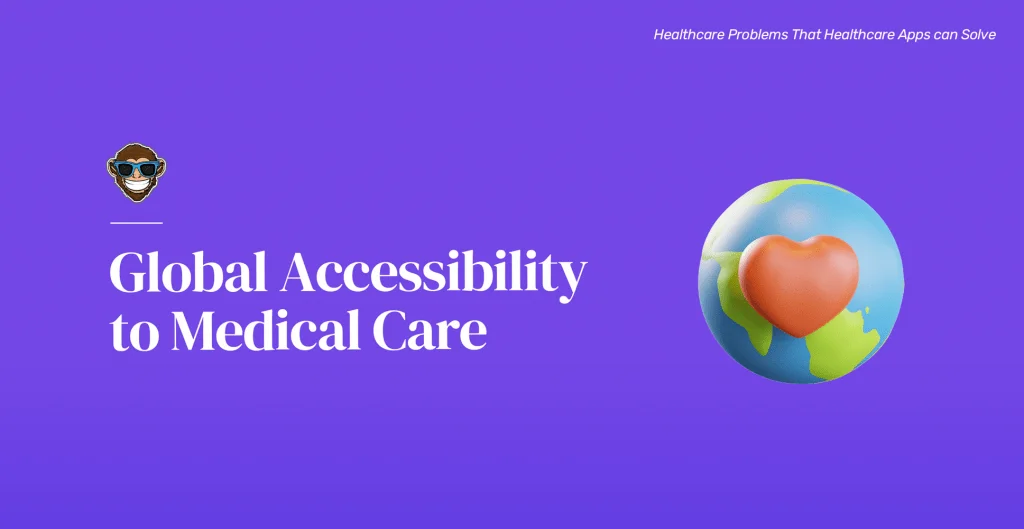
2. Global Accessibility to Medical Care
Access to healthcare and the availability of medical care options vary significantly from country to country; that’s no secret. And, in case there was any doubt, Covid has aptly shown that healthcare is not guaranteed for everyone. However, even before the pandemic, we already knew that more than half the world’s population lacked access to essential health services. For instance, in developing countries, people living in rural areas have to travel great distances to access a healthcare facility. This phenomenon has exacerbated healthcare accessibility issues in some regions, as the United Nations’ International Labour Organization (ILO) found. Their report concluded that 56% of the world’s rural area dwellers remain devoid of access to critical medical care, with Africa reaching an overwhelming 83% of uncovered rural denizens.
In addition to those concerning figures above, global healthcare coverage barriers include lack of medical institutions and healthcare infrastructure, shortage of medical professionals, poor or no medical equipment, large geographic distances, extreme weather conditions, high commute costs, and lack of transportation options. These factors increase the risk of worsening medical emergencies. As a result, the onset and progression of chronic illnesses accelerate, ending up in poor outcomes and death, especially for those living in isolated rural communities. Furthermore, it reduces the chances of efficient follow-up care and limits treatment success, thus increasing physical and emotional stress and reducing successful outcome rates.
Solution
• Telemedicine and Remote-monitoring Apps
The fact remains that social protection initiatives, such as global healthcare coverage schemes, are the primary and most effective way to address these inequalities. However, healthcare app developers can deliver mobile solutions to provide relief to the millions of patients who can’t access medical services. Telemedicine apps and other remote-oriented platforms can provide a reliable platform for medical professionals to provide quality care to patients who otherwise couldn’t access medical services. And although somewhat limited to the available network infrastructure and device availability of the area, telemedicine apps give people access to on-demand physicians, anywhere, anytime, without geographical barriers, which also increases the quality of medical care they can access. These patients can consult with physicians who can check for symptoms, make diagnoses, and suggest treatment avenues that would otherwise be impossible–or harder–to access in person.
Telemedicine apps could significantly improve access to medical services in these underdeveloped or isolated regions. And, even in non-underdeveloped areas, telemedicine can provide a cost-effective, convenient alternative for patients who can’t, or won’t, physically go to see a doctor in-office. This way, telemedicine, and remote-monitoring apps can expand healthcare coverage without the need for physical infrastructure and can improve outcomes for patients worldwide, regardless of where they reside.
Some of the top telemedicine apps are:
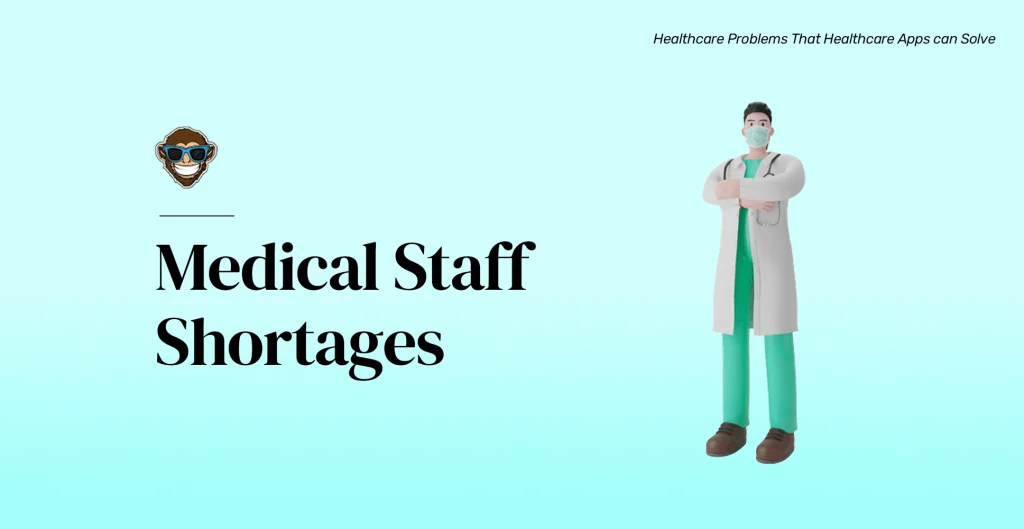
3. Medical Staff Shortages
In addition to the concerning figures mentioned above, low pay, overworking, and burnout among healthcare workers have resulted in a massive shortage in doctors and nurses that further underscores coverage issues. In fact, according to the World Health Organization (WHO), over 45 countries in the world have less than one doctor per 1,000 patients, with Tanzania and Jharkhand (India) having a concerning one physician per 2,500 and 8,900 patients, respectively. What these figures sadly show us is that healthcare services in these areas are basically non-existent. Nonetheless, the healthcare staff shortage issue is becoming more widespread, especially after the pandemic, with first-world countries suffering from understaffed hospitals and physician burnout. For instance, almost 20% of the country’s hospitals have staffing issues in the US, with North Dakota reporting a 50% medical worker shortage. And those numbers could be even higher if we consider that not all hospitals report their daily staffing situation. Still, needless to say, the figures we do know are already highly concerning.
Additionally, the lack of healthcare coverage and access is getting more acute due to the shortage of medical professionals. Healthcare workers are a prerequisite to secure access to healthcare services. It’s basic logic: you can’t get medical care if no one is available to give it to you. Thus, there is no possibility of high-quality healthcare services without skilled physicians, nurses, and other medical workers. Furthermore, the impact of understaffed–and underfunded–healthcare systems touches every aspect of human life and leads to countless ailments and issues that further saturate the system. Namely, more than 1 billion people in the world live with uncontrolled hypertension. Another 1 billion people lack access to primary eye care, and, on top of that, nearly 1 in 2 people with diabetes go undiagnosed due to no access to qualified clinicians.
Solution
• Workforce management apps
To avoid overworking physicians and increasing burnout rates that lead to high turnover, hospitals and practices worldwide can implement a workforce management mobile or web app. These types of tools can help institutions keep an eye on their staff’s working hours and optimally distribute their staff’s work schedules to avoid long shifts and over-scheduling, which can help reduce burnout and turnover rates. Additionally, medical institutions can use workforce management apps to streamline their processes, translating to stress-free staffing, more accurate and flexible schedules, better patient care, and less overtime. These facts ensure that all medical staff needs are met and promote medical service availability by keeping qualified professionals on-call at all times.
Some of the most prevalent healthcare workforce management apps are:
• Telemedicine
Once again, telemedicine apps come to save the day. Thanks to apps that offer remote medical care, healthcare providers don’t need to be in the office to treat their patients. This way, working from home–or remotely from their office–allows them to offer more flexible appointment hours, see more patients in less time, expand their geographic coverage, and tend to more patients without stepping outside their comfort zone. Additionally, they can dedicate more time to stressful tasks such as emergency consultations or intensive care patients and put some hours back into their day to lighten their workload. Granted, telemedicine won’t solve every problem in the modern physician’s environment, but virtual care delivery can significantly increase their life quality. As a result, doctors can decrease their stress levels and perform their jobs in a better, more efficient way to provide the best care to their patients.
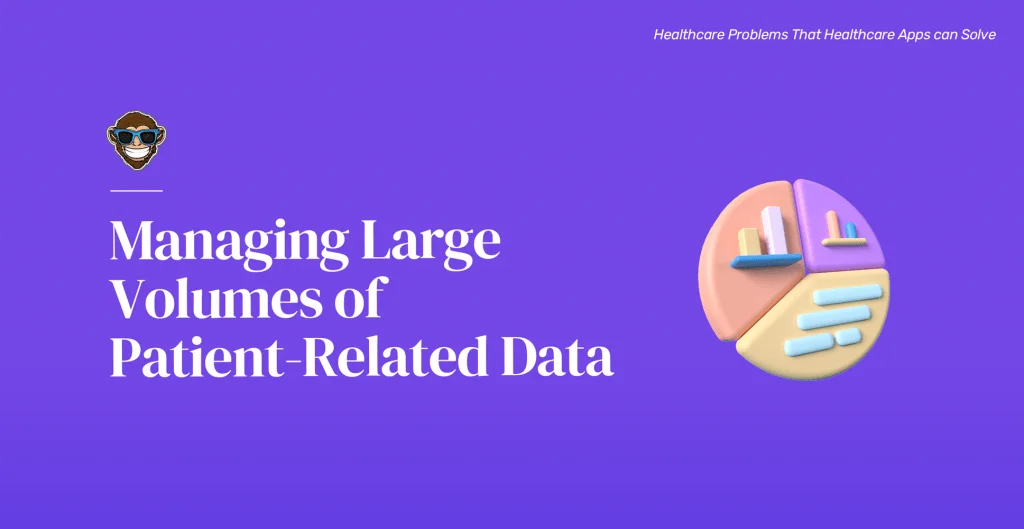
4. Managing Large Volumes of Patient-Related Data
In the modern healthcare ecosystem, managing patient-related data, especially when it’s all in digital form, can be one of the most overwhelming aspects of healthcare practices around the globe. It is estimated that today, one patient generates about 80 megabytes per year in imaging and electronic health record (EHR) data. If we factor in that, on average, a person visits the doctor 3.2 times per year; we can safely conclude that, with each new addition to the patient database, the pool of medical data will keep growing and, without the proper tools, it will eventually become unmanageable. Additionally, experts predict that big data from healthcare will experience a compound annual growth rate (CAGR) of 36% by 2025, making it the highest data growth sector in the world.
Besides, additional data demands impact patient data management, such as treatments, medications, vaccines, single-patient diagnoses, and treatments across multiple providers. The storage and retrieval of all this patient data are becoming a challenge for practices and physicians as the number of sick patients and illnesses grows. If this challenge isn’t adequately addressed, data overload and mismanagement can start to become commonplace and will inevitably lead to misdiagnoses, data breaches, wrong treatments, lapsed appointments, and failure to monitor patients’ conditions, to name a few. The implications of making these mistakes can be catastrophic for stakeholders and can significantly impact the quality and availability of medical care delivery.
Solution
• Apps and Software That Enable Health Data Management (HDM)
Health Data Management (HDM) is the way medical institutions organize health data in digital form. These ways of organizing can range from Electronic Medical or Health Records (EHR/EMR) to handwritten medical notes that are scanned or lab test results stored in a patient’s file or a digital repository. On that same note, healthcare organizations can choose to manage all that data on-premise by building their own data centers or opt for a cloud-based storage system. The latter is the best choice to ensure physicians can use the data when and where they need it. Whichever the case, HDM is not just about organizing patient data but also integrating it with the existing systems and enabling its prompt access and analysis to potentialize efficient patient care. This way, using healthcare mobile and web apps that can easily integrate with this system can provide physicians with real-time access to organized patient-related data and provide them with the flexibility to access said information while on the go throughout their mobile and desktop devices. And, since the storage and retrieval of patient data are cloud-based, medical and personal records are updated in real-time, secure, and compliant with regulatory laws.
A study from a few years back shows that 89% of surveyed healthcare organizations were using cloud-based apps for their data management needs. By now, that number has undoubtedly risen, and a growing number of healthcare organizations are surely building their IT infrastructures to be cloud-based. In addition, the mobility and flexibility provided by cloud-based healthcare mobile apps and software make data handling more flexible and scalable, crucial features to meet the growing data size and demand.
Some mobile and web cloud-based apps that enable patient data management are:
• mHealth Apps
mHealth is gaining traction among healthcare practices these past few years. It encompasses medical treatments and diagnoses supported by mobile applications on smartphones, tablets, health monitors, wearables, IoMT devices, and other wireless equipment. When used in tandem with these devices and monitors, mHealth apps help physicians gather data about their patients’ vital signs, behaviors, and overall health conditions, all in real-time. As a result, mHealth apps help doctors provide better treatment avenues without depending on sophisticated data management strategies, analytics, or waiting for data from data centers.
mHealth apps can also gather specific data about disease behavior, progression, and genetic predispositions. They can also help enrich medical research and promote the proper data sharing tools and cross-institution data transfer. Most mHealth apps can also help solve most of the other problems in this article, such as increasing accessibility to medical services, freeing physician workloads, and help the entire healthcare system achieve higher coverage levels and save more lives.
Some of the most downloaded and popular mHealth apps that enable medical data collection include:
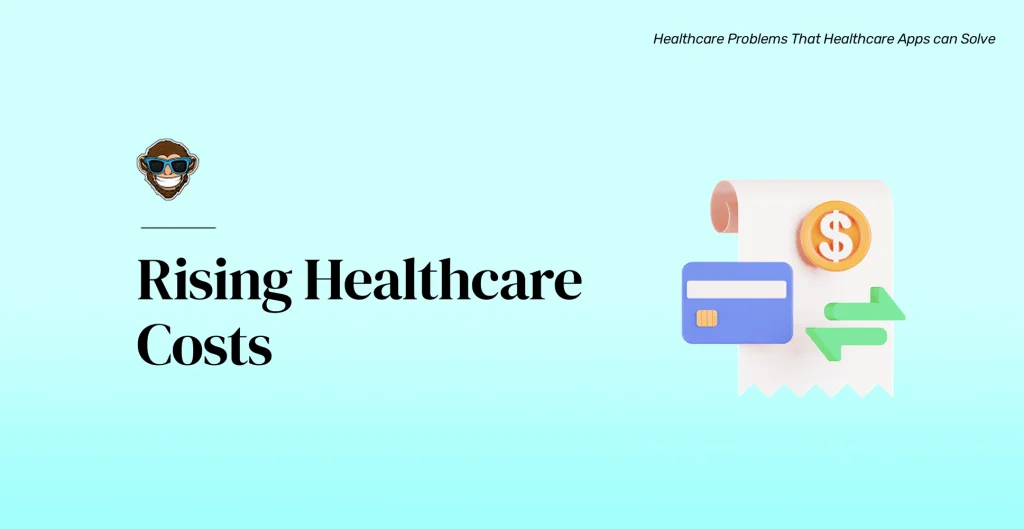
5. Rising Healthcare Costs
Last but definitely not least, rising healthcare costs are one of the system’s most concerning issues and one of the main reasons why vulnerable regions have such low medical care coverage rates. These rising costs are adding excessive pressure to the industry and affect medical professionals, caregivers, patients, healthcare companies, hospitals, governments, cities, and even entire countries. For instance, in the US, reports show that healthcare spending was at almost $3.8 trillion, or $11,582 per person, in 2019. By 2028 however, it will reach $6.2 trillion—roughly $18,000 per person. In Africa, healthcare costs rose from 8.5% in 2019 to 9.3% in 2020, while globally speaking, prices rose about 6.8%.
As concerning as those figures are, healthcare costs are likely to keep rising due to the following factors:
- Aging population: As the world’s population ages, the demands on the healthcare system will inevitably increase. Older people require more healthcare services and the types of care are usually more resource-intensive and expensive.
- Increasing global population: As of right now, there are almost 8 billion people globally, with the birth rate more than doubling the death rate. Theoretically, all those 8 billion people are potential healthcare users, meaning the sector’s growth rate must keep up with the pace of population growth.
- Unhealthier habits: Approximately one in three adults worldwide suffer from multiple chronic conditions. Additionally, the number of obese and overweight individuals keeps rising as eating and drinking habits worsen each year.
- Monopolization of healthcare services: The consolidation and monopolization of the healthcare sector have decreased the market competition in several countries. Without competition, monopolies are in a position to drive up healthcare and insurance prices while remaining unopposed.
Solution
• Healthcare mobile apps
Healthcare mobile apps and other software solutions provided by developers once again come to save the day. The truth is, every mobile or web healthcare app out there aims to help reduce or minimize rising healthcare costs. Some are successful at it, others not so much. Whichever the case, healthcare mobile apps can release some of the monetary pressure on the system and enable many non-traditional avenues for medical care delivery that promote better coverage and accessibility. Moreover, healthcare apps are becoming the right hand of many practitioners, pharma companies, and institutions due to the myriad benefits they provide that end up in cost reductions for all stakeholders and, in turn, for the system itself. As a matter of fact, surveys have shown that 93% of physicians believe that healthcare mobile mobile apps can help improve patient outcomes in the US, and 89% of them would recommend an app to their patients. These numbers aren’t surprising for us, considering that the popularity of healthcare mobile apps has grown consistently for years now, with a market worth of $40.05 billion in 2020 and an expected growth of 17.7% for 2028.
Healthcare mobile apps can achieve healthcare cost reduction by helping stakeholders:
Tend to chronic diseases more efficiently: Healthcare app integration with wearables and medical monitoring devices can help physicians keep an eye on their patients’ conditions more efficiently and in real-time. They can track illnesses and their progression, thus avoiding their onset or stopping them from worsening. Preventing disease could potentially save the US healthcare system about $7 billion per year.
Avoid non-emergency admissions in ERs: According to the CDC, around 50% of ER visits each year are non-urgent. This phenomenon is costing the system on average $2,000 per non-urgent ER visit. Healthcare apps can help counteract some of these expenses by providing triage and symptom checker options before the ER visit to help the patient determine if their condition warrants an emergency room visit. Additionally, medical apps can also alert physicians if one of their patients is experiencing acute symptoms and needs urgent care. This way, healthcare mobile apps can help filter outpatient traffic for emergency rooms, reducing the expenses of non-urgent visits and ER physician burnout rates.
Improve medication adherence: Studies show that medication and treatment non-adherence causes around 125,000 deaths each year and costs the healthcare system between $100–$289 billion. Healthcare mobile apps can help reduce these worrying costs by enabling physicians to monitor their patients’ treatment and send reminders or timed push notifications to improve patient education and promote medication adherence.
Empower patients to take charge of their health: A link has been long identified between a patient’s control of their health conditions and successful health outcomes. Healthcare apps that promote patient education, let them track their progress and symptoms, and let them play a part in managing their conditions can significantly reduce chronic illness incidence and improve health outcomes.
Reduce unnecessary readmissions: Hospital readmissions cost the US healthcare system around $26 billion annually. Healthcare apps play a chief role in preventing readmissions by achieving all of the benefits mentioned above. In addition, proper illness monitoring, treatment adherence, patient engagement, and integration with monitoring devices can significantly reduce readmissions and the staggering costs that come with them.
The number of available healthcare apps and the amount of wearables and sensors connected with them keeps growing. Every day more than 200 healthcare apps are released, with over 400,000 available in major app stores. These figures encourage and attest to the undeniable benefits that healthcare apps bring to medical ecosystems and healthcare institutions worldwide.
Some of the most popular and innovative healthcare mobile and web apps that enable all the features and benefits exposed above are:
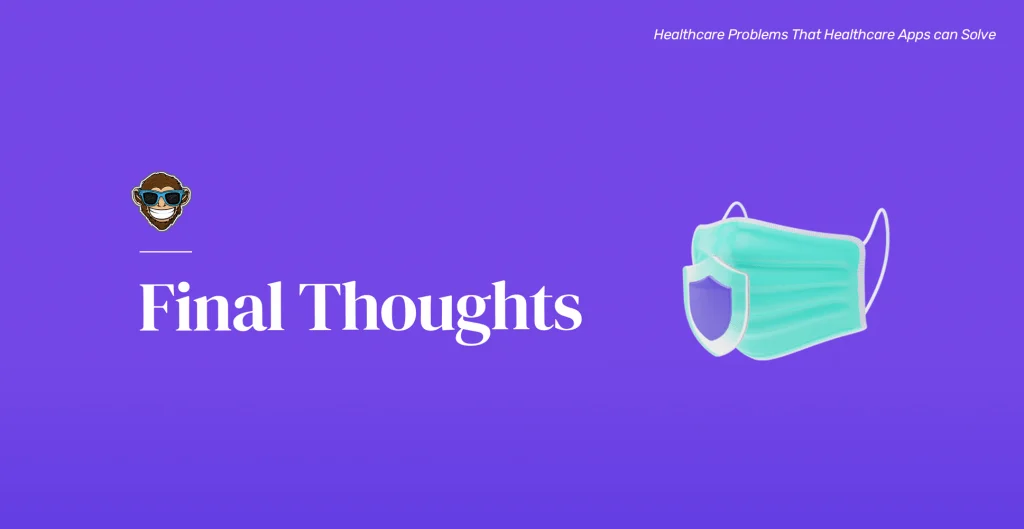
Final Thoughts
It’s a fact: mobile digital technologies are changing the way healthcare systems around the world function. Healthcare apps are no longer exclusively associated with fitness and wellness. Instead, they are expanding and growing to become more innovative and more helpful in improving patients’ health conditions and decompressing, albeit slowly, a global healthcare system that has been hit repeatedly especially this past year.
Moreover, as the healthcare app development world continues to innovate and launch more robust, advanced mobile healthcare solutions, we will indeed witness improved costs, coverage, accessibility, shorter wait times, and overall better patient engagement and outcomes. And, if the global healthcare system continues to experience issues, mobile healthcare solutions will continue to exist solely, to solve those issues and secure a place for every person on the planet in the healthcare ecosystem.
At Foonkie Monkey, we love building secure and innovative healthcare apps that do their part in improving our users’ lives. So, if you are looking into building a mobile or web-based healthcare solution, let’s talk and create something incredible together!
